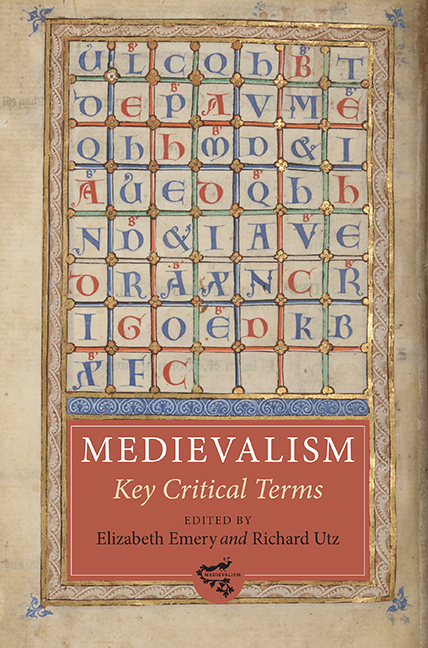Book contents
- Frontmatter
- Dedication
- Contents
- List of Illustrations
- List of Contributors
- Making Medievalism: A Critical Overview
- 1 Archive
- 2 Authenticity
- 3 Authority
- 4 Christianity
- 5 Co-disciplinarity
- 6 Continuity
- 7 Feast
- 8 Genealogy
- 9 Gesture
- 10 Gothic
- 11 Heresy
- 12 Humor
- 13 Lingua
- 14 Love
- 15 Memory
- 16 Middle
- 17 Modernity
- 18 Monument
- 19 Myth
- 20 Play
- 21 Presentism
- 22 Primitive
- 23 Purity
- 24 Reenactment
- 25 Resonance
- 26 Simulacrum
- 27 Spectacle
- 28 Transfer
- 29 Trauma
- 30 Troubadour
- Index
- Medievalism
23 - Purity
Published online by Cambridge University Press: 08 October 2022
- Frontmatter
- Dedication
- Contents
- List of Illustrations
- List of Contributors
- Making Medievalism: A Critical Overview
- 1 Archive
- 2 Authenticity
- 3 Authority
- 4 Christianity
- 5 Co-disciplinarity
- 6 Continuity
- 7 Feast
- 8 Genealogy
- 9 Gesture
- 10 Gothic
- 11 Heresy
- 12 Humor
- 13 Lingua
- 14 Love
- 15 Memory
- 16 Middle
- 17 Modernity
- 18 Monument
- 19 Myth
- 20 Play
- 21 Presentism
- 22 Primitive
- 23 Purity
- 24 Reenactment
- 25 Resonance
- 26 Simulacrum
- 27 Spectacle
- 28 Transfer
- 29 Trauma
- 30 Troubadour
- Index
- Medievalism
Summary
WHEN EDMUND SPENSER wanted to write an epic that could “fashion a gentleman or noble person in vertuous and gentle discipline,” he produced the Faerie Queene, a poem that drew on medieval romance tropes, medieval allusions, and the medieval mode of allegory to edify a Renaissance audience. Eighteenth-century Gothic novelists like Horace Walpole and Ann Radcliffe summoned readers to a mystical, occult past while their own world lost its mysteries to the Enlightenment. William Blake and Sir Walter Scott became entranced with the Middle Ages as their environments darkened with the grit and smog of industry, and Tennyson and Swinburne hung their poetry on idyllic visions of beautiful, virginal maidens and brave, boyish conquerors from the past even as England's imperial subjects rebelled against their colonization. The Middle Ages has represented a period of innocence and moral purity to writers and artists throughout modernity; even Mark Twain's A Connecticut Yankee in King Arthur's Court, which mocks medieval credulousness as ignorance, has longing mixed with its loathing, longing for a retreat from cynicism and scientific certainty, and for a world full of wonder.
And yet, there has always been a darker side to humanity's nostalgia for the “unspoiled” past. The same purity imagined by Spenser, Tennyson, and their counterparts has also been embraced by the Ku Klux Klan, Nazi Germany, and fundamentalist sects of religious movements, all of which imagine the medieval era as a pristine space in which whiteness and masculinity assume a prevalence naturalized by the soft focus of medievalism's pseudo-historical lens. For each of these authoritarian cultures, medievalism is the symbolic medium through which members are encouraged to perform according to prescribed roles, falling into place based on the imagined historicity of class, race, and gender.
While the English under Victoria's reign gloried in Pre-Raphaelite paintings and misty poetic tributes to the Lady of Shalott, the other side of the pond became enamored with the Middle Ages as well. This was particularly true of the American South, which imagined itself as a neo-feudal empire crushed into ruin by northern barbarians during the Civil War.
- Type
- Chapter
- Information
- Medievalism: Key Critical Terms , pp. 199 - 206Publisher: Boydell & BrewerPrint publication year: 2014

